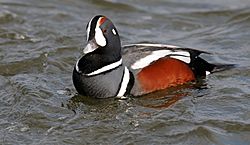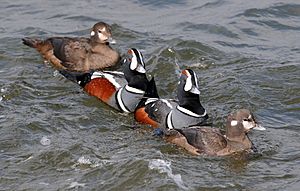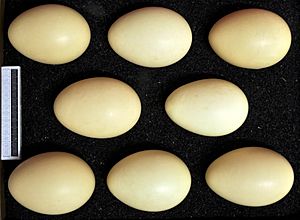Harlequin duck facts for kids
Quick facts for kids Harlequin duck |
|
|---|---|
 |
|
| Adult drake | |
| Conservation status | |
| Scientific classification | |
| Kingdom: | |
| Phylum: | |
| Class: | |
| Order: | |
| Family: | |
| Subfamily: | |
| Genus: |
Histrionicus
Lesson, 1828
|
| Binomial name | |
| Histrionicus histrionicus (Linnaeus, 1758)
|
|
The Harlequin duck is a duck that lives in the sea. The female is plain, but the male has white markings. This is called disruptive coloration The male can be difficult to see against surfaces that are not a solid color, like water that ripples. The point is that it disrupts the appearance of body shape, but there are other explanations.
Description
Adult breeding males have a colorful and complex plumage pattern. The head and neck are dark slate blue with a large white crescent marking in front of the eye, a small round dot behind the eye, and a larger oval spot down the side of the neck. A black crown stripe runs over the top of the head, with chestnut patches on either side. A black-bordered white collar separates the head from the breast.
The body is largely a lighter slate blue with chestnut sides. A black-bordered white bar divides the breast vertically from the sides. The tail is black, long and pointed. The speculum is metallic blue. The inner secondary feathers are white and form white markings over the back when folded. The bill is blue-grey and the eye is reddish. Adult females are less colourful, with brownish-grey plumage with three white patches on the head: a round spot behind the eye, a larger patch from the eye to the bill and a small spot above the eye.
Distribution and habitat
Their breeding habitat is cold fast moving streams in north-western and north-eastern North America, Greenland, Iceland and eastern Russia. The nest is usually located in a well-concealed location on the ground near a stream. They are usually found near pounding surf and white water. They are short distance migrants and most winter near rocky shorelines on the Atlantic and Pacific coasts. They are very rare migrants to western Europe.
The eastern North American population is declining and is considered endangered. Possible causes include loss of habitat due to hydroelectric projects and loss of life due to oil spills near coastal areas.
Behaviour
These birds feed by swimming under water or diving. They also dabble. They eat molluscs, crustaceans and insects. Harlequins have smooth, densely packed feathers that trap a lot of air within them. This is vital for insulating such small bodies against the chilly waters they ply. It also makes them exceptionally buoyant, making them bounce like corks after dives.
Images for kids
See also
 In Spanish: Histrionicus histrionicus para niños
In Spanish: Histrionicus histrionicus para niños





